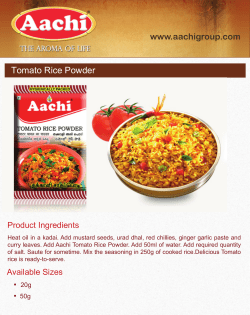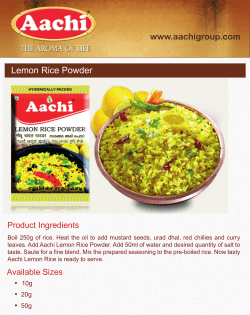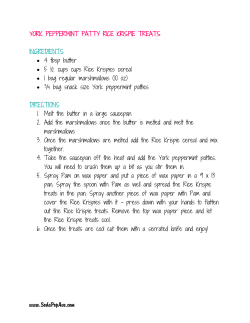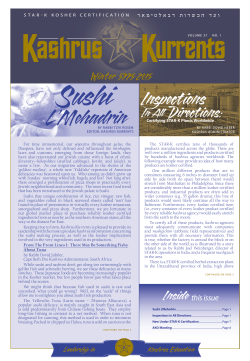
SUSHI by Sarah Snyder and Libin Korah Kentucky State Food Code KRS 217.005-217.992
SUSHI by Sarah Snyder and Libin Korah 1 Kentucky State Food Code KRS 217.005-217.992 Kentucky Food Drug and Cosment Act 902 KAR45:005 Definitions • Sushi: ready-to-eat cooked rice that has been acidified with vinegar solutions formed with raw or cooked fish and other seafood such as imitation crabmeat made from surimi (fish based food product), fresh chopped vegetables, pickles, tofu, etc. • Sashimi: thin slices of raw fish that are presented ready-to-eat. 2 Sushi statistics • Served in over 60 facilities in the Louisville Metro Area. • Potentially Hazardous so it must be prepared, stored, and served in a proper manner. • Growing trend (Even in some Mexican and American restaurants). • Complicated process to ensure food safety. 3 Options for Sushi Rice 1. Hot or Cold holding at proper temperatures HACCP Plan and Variance NOT required 2. Use Time as a Public Health Control Written Procedures and Documentation required 3. Render rice non-potentially hazardous by adding vinegar to acidify and be held at room temperature (pH control) HACCP Plan and Variance required 4 1. Temperature Control • Rice is cooked, acidified, properly cooled, and held cold (41 degrees Fahrenheit or less). • Rice is cooked, acidified, and held hot (135 degrees Fahrenheit of above). 5 2. Time as a Public Health Control • KRS 3-501.19 • Time only, rather than temperature controls. • For ready-to-eat potentially hazardous food displayed or held for service and for immediate consumption. 6 2. Time as a Public Health Control • Must be served or discarded within 4 hours. • Must be marked or otherwise identified with the time to serve or discard. • Cannot be removed from time control and returned for use at a later time. • When time expired (or if something does not get marked) – Food must be discarded. 7 2. Time as a Public Health Control. • Facility must have written procedures to ensure compliance with the previous requirements (attached). 8 3. pH Control • Rice must be prepared to maintain the pH 4.2 or below. Most common method is acidification with vinegar. • Requirements include a written recipe for preparation and instructions on how to properly acidify rice, a calibrated pH meter to measure pH level and a log sheet to document daily pH readings. 9 3. pH Control • Preparation of Rice: -Dedicated sink and table for preparation of rice and sushi. Should be clean and sanitized before handling food. -Clean and properly supplied hand washing facilities. - Clean and sanitized containers and utensils. - Bamboo and plastic mats are lined with plastic film and rewrapped within 4 hours after continuous use or contacting different sushi products. Mats cleaned and sanitized daily. 10 Measurement of pH • Conduct pH test within 30 minutes after acidification of cooked rice to get a target pH of 4.2 or below. • Make a rice slurry by gathering a ¼ cup sample of cooked, acidified rice taken from various locations in the batch and add ¾ cup of distilled water in a clear cup. • Blend the slurry for 20 seconds to create a thorough mix. 11 Measurement of pH • Insert pH probe into liquid portion of slurry. Repeated measurements with a new slurry from the same batch are recommended to assure a proper reading. • Use manufacturers recommendations for taking pH measurements. 12 Recording pH • Record daily pH readings in a pH log sheet (Example of a pH log sheet is attached). • pH meters must be calibrated according to manufacture’s instructions. • Brown rice cannot be acidified due to hard surface coating. Must be kept at proper temperature (≤ 41◦ F or ≥ 135 ◦ F) or Time as a Public Health Control. 13 About pH • A change of one unit represents a change of 10 fold in acidity. For example: a pH of 4.0 is 10 times more acidic than a pH of 5.0. • A pH of 4.3 (minimum required to control B. cereus) is 3 times more acidic than a 4.6 (required to control C. Botulinum). • Each change in pH of 0.1 is, therefore, very significant. 14 Risks Associated with Sushi • There are many microbes and parasites associated with raw, undercooked or partially cooked foods. • Pathogens includes bacteria species such as B. Cereus and Vibrio species and parasites such as nematodes and roundworms. • Due to the potential risks, consumer advisories are required on menu items. 15 Bacillus Cereus • • • Type of bacteria that produces toxins. The toxins are heat resistant. B. Cereus is found in soil and in plant foods. When the product (rice) is dry it remains dormant as spores. Once water is added they germinate and grow. The heat process does not kill the spores so they multiply if held in the “Danger Zone” (42-134 degrees Fahrenheit • These toxins can cause two types of illness. 1.) First type characterized by diarrhea. Onset time is 6 to 15 hours; duration is less than 24 hours. 2.) Second type is emetic toxin which can cause nausea and vomiting. Onset time 30 minutes to six hours; duration is less than 24 hours. 16 Vibrio Species • Vibrio parahaemolyticus has been associated with consumption of raw or undercooked fish and shellfish. Infection can result in diarrhea, abdominal cramps, nausea, vomiting and fever. • Onset time is 2 to 48 hours. Duration is 2 to 8 days. • Vibrio vulnificus- has been found in oysters, clams, and crab. • Infection can cause vomiting, diarrhea and abdominal pain. In people with weakened immune system, the microbe can enter the bloodstream and cause septicemia, a lifethreatening condition. • Onset time is 1 to 2 days. Duration 2 to 8 days. 17 Parasites • Human infection by Anisakis simplex aka the Herring worm and other nematodes, or roundworms can be caused by eating certain raw or undercooked fish. • Ingestion causes severe abdominal pain, nausea, and vomiting within hours of ingestion. • Can cause Anaphylactic shock. 18 Further Requirements • Facilities are required to have parasite destruction documents for all sushi products except large species of tuna, farm-raised salmon and farm-raised/pellet-fed fish. • Parasite Destruction Records: - Obtain parasite destruction records from supplier or manufacturer. (3-402.11) 19 Products Exempt from Parasite Destruction • Molluscan Shellfish • Tuna of the species Thunnus alalunga, Thunnus albacores (Yellowfish tuna), Thunnus atlanticus, Thunnus maccoyi (Bluefish tuna, Southern), Thunnus obesus (Bigeye tuna), or Thunnus thynnus (Bluefin tuna, Northern); or • Aquaculture fish, such as salmon, that: • 1.) If raised in open water, are raised in net-pens or • 2.) Are raised in land-based operations such as ponds or tank and • 3.) Are fed formulated feed, such as pellets, that contains no live parasites ineffective to the aqua-cultured fish. 20 Contact Information • For further questions, please contact: Gretchen Boyd, RS Food Inspection Supervisor Louisville Metro Department of Public Health and Wellness 400 East Gray Street Louisville, KY 40202 502-574-6650 21 References KY State Food Code KY Food, Drug and Cosmetic Act http://www.foodsafety.gov/bcereus/index.html http://www.health.state.mn.us/divs/eh/food/pwdu/fs p/meetings/2011/411susfreezing.pdf • http://www.vdh.state.va.us/EnvironmentalHealth/FOO D/FoodSafety/guidanceDocs/GuidanceFiles/Food/AFD O%20sushi%20rice%20model%20recipe.pdf • http://infectiousdiseases.about.com/od/g/a/Sushi.htm • http://www.cdc.gov • • • • 22 Attachment A Log sheet for Time as a Public Health Control Date Time Rice is Prepared Discard Time (Must be 4 hours from set time) 7/1/2012 11:00 AM 3:00 PM 7/1/2012 5:00 PM 9:00 PM 7/1/2012 7:00 PM 11:00 PM • Time Stamp must be on each batch of rice. The stamp must specify if it is time made or time of discard. 23 Attachment B 1) The preparation of first batch of rice begins at 10 am and after completion of preparation is when time begins. In this case, time begins at 11 am. 2) The first batch of rice will be discarded at 3pm (4 hours from the time when the rice is put at room temperature). 3) The preparation of second batch of rice begins at 4pm and set at room temperature at 5pm. 4) The second batch of rice is discarded at 9pm. 5) If your hours of operation exceed this time period, please make additional batches of rice and document the time as needed. 24 Attachment C Log Sheet for pH Measurement Date 7/2/2012 Time 10:00 AM • pH must be taken from each batch of rice. pH of Rice (Must be at or below 4.2) 4.2 25 Questions 26
© Copyright 2025





















